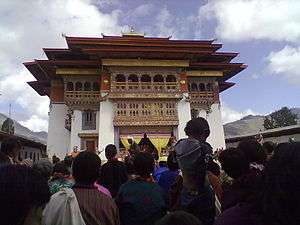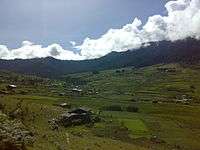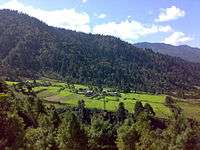Phobjikha Valley
| Phobjikha Valley | |
|---|---|
|
View of Phobjikha Valley During Sunset | |
| Floor elevation | 3,000 m (9,800 ft) |
| Geography | |
| Population centers | Phobji Gewog, Gangteng Gewog |
The Phobjikha Valley ཕོབ་སྦྱིས་ཁ (also spelt Phobjikha and, in the past, Phubjikha,[1] the suffix kha means valley in Dzongka) is a vast U-shaped glacial valley, also known as Gangteng Valley named after the impressive Gangteng Monastery of the Nyingma sect in central Bhutan, where the graceful black-necked cranes in Bhutan (Grus nigricollis) from the Tibetan Plateau visit the valley during the winter season to roost. On arrival in the Phobjikha Valley in the last week of October, the black-necked cranes circle the Gangteng Monastery three times and also repeat the process while returning to Tibet.[2][3][4]:152–154
The broad valley with its best-known marshland in Bhutan, is popular for its scenic splendour and cultural uniqueness. The valley is rich in faunal biodiversity and has, apart from the globally threatened black-necked cranes Grus nigricollis, 13 other globally threatened species. Within the ambit of the valley, an area of about 163 square kilometres (63 sq mi) has been declared a protected area, which is managed by the Royal Society for the Protection of Nature (RSPN), for the protection of nature, authorized to manage, on lease basis, by the Ministry of Agriculture.
Tsechu, the colourful Mask Dance Festival of Bhutan and the Crane Festival welcoming the black-neck cranes in winter months are held every year in the precincts of the Phobjikha Valley, in the Gangten Monastery courtyard. It also has a popular 3-days trek route.
Geography

The Phobjikha Valley is a vast glacial valley at an elevation of about 3,000 metres (9,800 ft) on the west side by the Black Mountains (Bhutan) (range above 5,000 metres (16,000 ft) elevation) that separates western and central Bhutan. The valley covers most of Phobji and Gangteng Gewogs and some parts of Athang Gewog and contains the Gangteng Monastery, also known as Gangtey Gonpa, on a spur surrounded by the village Gangtey. The valley also hosts one of the eight Lings built by a great Buddhist saint Longchenpa which is called Ngelung Drechagling. The valley is covered by a rich sward of grass in the marshy land where special variety of dwarf bamboo (Yushania microphylla) grows on which the black-necked cranes feed. The Nake Chuu and Phag Chuu River runs through this valley. Scenic views of the Phobjikha Valley are best below the spur of Gangteng Monastery and from the Ngelung Drechagling Lhakhang.[3][4][6][7][8]
- Climate
The valley is enclosed by the mountain ranges, which experience snowfall. The valley also gets covered with snow during the winter months forcing people of the valley to shift to more pleasant climes during the months of January and February. The mean minimum temperature recorded in December is −4.8 °C (23.4 °F). The mean maximum temperature recorded in August is 19.9 °C (67.8 °F). The rainfall incidence varies from 1,472–2,189 millimetres (58.0–86.2 in).[4][9]
Economy

The Phobjikha Valley, with its agrarian economy, is mostly underdeveloped with least modern facilities of water and sanitation. Transport and communication facilities are also not adequate. But with the development of the country, the two mobile service providers of the country established the cellular networks. This connected the valley to the rest of the world. B-Mobile installed its first cellular network in the year 2008 during the consecration ceremony of the newly built Gangten Gonpa. In view of protection provided to the cranes which visit the valley in winter, as a conservation measure overhead transmission lines for electric supply have not been permitted to be provided.[10] Solar heaters, solar powered cells and diesel generators are used to provide electricity in the past but now the valley is connected to the national grid using underground electrical cable system.[9]
Demographics
The Phobjikha Valley is located in the Wangdue Phodrang District (Phobji and Gangteng Gewogs) in central Bhutan. The valley has about 4,500 people (4,716 has been reported[9]) residing in Gangten and other villages, and in the Gangten Monastery that is strategically located on a spur above the valley. During the winter season, as the valley gets covered by snow, some population of the valley including the monks shifts to a more conducive climate (during months of January and February) in the Wangdue Phodrang area, which is about 3,000 kilometres (1,900 mi) away by road. The ethnicity of the people living in the valley has a special identity and their language is a dialect known as Henke (inferred to be archaic Tibetan), a language under the Bumthang group of languages. The Black Mountain Region is also inhabited by nomadic shepherds and yak-herders. The ancient animistic religion of Bhutan namely, the Bon religion, is still practiced by some of the villagers.
Flora and fauna

The picturesque Phobjika Valley, in the backdrop of the Black Mountain Range, has rich biodiversity of flora and fauna. This, coupled with religious importance of the Gangten Monastery, has attracted religious and ecotourism to the valley.[4]
- Vegetation
The Phobjika valley is a marshy land and has a sward of grassy pastures where cattle and horses graze. A special kind of dwarf bamboo grows here, which attracts the black-necked cranes to roost and feed in the valley during the winter season. Potatoes are the main cash crop grown in the valley. Turnips are also grown. Other tree species seen are coniferous vegetation of blue pine, birch, maple and several species of rhododendrons.[4][9]
- Crops
The valley is known for its seed potato crop as the soil and atmospheric conditions in the valley are free from insects and diseases that normally affect this crop. The crop is mainly exported to India where there is great demand for this variety. This has generated interest in the valley to convert the wetlands or marshy lands of the valley into farms by draining the area of its water logging to produce cash crops. However, interest to preserve the habitat of the black-necked crane in the valley, the religious significance that is attached to the black-necked cranes, and the tourism that has developed around the famous Gangten Monastery and the cranes, the institutions like the Royal Society for the Protection of Nature (RSPN) have prevailed upon the Government of Bhutan to stop any conversion of the valley land into farms. Palje "Benjie" Dorji, former Chief Justice of Bhutan, former Minister for Environment and uncle of the present King of Bhutan, as the Chairman of the Royal Bhutan Society and as founder of the Black-necked Conservation Programme helped to drop the proposal to drain the wetlands of the Phobjika Valley to create farms to grow cash rich seed potatoes.[2][4] However, it has been suggested that as cranes are valued more, the people who cannot grow cash rich potatoes here need to be compensated.[11] It has also been suggested that the effect of tourism on cranes in the Phobjika Valley should also be studied.[12]
- Fauna
The valley and hills surrounding it are rich in wild life. The fauna recorded are the muntjacs (barking deer), wild boars, sambar, Himalayan black bear, Himalayan serow, leopards and foxes.[4]
- Avifauna
The Phobjika Valley has several vulnerable species of birds in the Protected Conservation Area established in 2003. The most celebrated species of the region is the black-necked crane. The other vulnerable species are the chestnut-breasted partridge (Arborophila mandellii), wood snipe (Gallinago nemoricola), Blyth's tragopan (Tragopan blythii), greater spotted eagle (Aquila clanga), imperial eagle (Aquila heliaca), Baer's pochard (Aythya baeri), Hodgson's bushchat (Saxicola insignis), dark-rumped swift (Apus acuticauda), and grey-crowned prinia (Prinia cinereocapilla).The Conservation Area of 163 square kilometres (63 sq mi), which includes Gewogs of Phobji, Gangte and Bjena under the Wangdue Phodrang dzongkhag, has been leased out for Conservation Planning and Management to the Royal Society for the Protection of Nature (RSPN), a non-governmental organization (NGO) set up in Bhutan in 1987 (legally incorporated in 1997). RSPN is involved not only in the conservation management of the black-necked cranes and their habitat but also in conducting research on public education and awareness, community empowerment for conservation, and integrated conservation and development programmes, including community-based ecotourism in the valley.[3] The black-necked cranes arrive in this valley in late October and depart in mid-February.[13]
Festivals

In the Phobjikha valley in particular, the black-necked cranes have a celebrity status, as witnessed by the Crane Festival held every year on 12 November, soon after their arrival from the Tibetan Plateau in the late October. The festival is celebrated in the courtyards of the Gangten Gonpa and in the entire Phobjikha Valley. The festival is attended by a large number of local people. On this occasion, children wearing crane costumes perform choreographed crane dances. During this period, cranes are seen flying at high altitudes over the mountains. Many tourists also visit the valley to witness this festival.[4][13][14]
Another special festival observed by the people of the valley is the annual Tsechu, which is held in the Gangteng Monastery from the 5th to 10th days of the eighth lunar month, as per the Bhutanese calendar. Mask dances are the special feature of the festival. The festival attracts many foreign tourists.[6]:828
Phobjikha Valley and Gangtey treks
Phubja Valley trek is a popular trekking that takes three days to complete and is part of the religious tourism and ecotourism that is promoted by the Government of Bhutan and other concerned NGO organizations.[4]
Gangtey treks are also popular tourism attractions in the Phobjikha Valley, which cover the Gangteng Gonpa. These trekking routes followed by international trekking enthusiasts start from the Gangteng Gonpa in the Phobjikha Valley. The treks pass through the Kumbu village (east of the Gonpa), goes through the Gedachen and Khebayathang villages, leads to the Kilhorthang village and terminates in the Kilkhortang Lhakhang.[15] A short trek of about 90 minutes known as the 'Gangte Nature Trail' starts from the Mani stone wall to the north of the Gangteng Gonpa and ends in Khewa Lhakhang.[4]:153
Gallery
 Summer in Phobjikha
Summer in Phobjikha Pisting village
Pisting village The valley as seen from Kephay
The valley as seen from Kephay Girls in national dress dancing during the annual Gangteng tshechu in Phobjikha Valley
Girls in national dress dancing during the annual Gangteng tshechu in Phobjikha Valley
See also
- Royal Society for the Protection of Nature (RSPN)
- Ngelung Drechagling Lhakhang
References
- ↑ 'Branch Post Office Phubjikha' in A list of Bhutanese Post Offices in Postal Himal, 4th Quarter 1992 http://himalaya.socanth.cam.ac.uk/collections/journals/postalhimal/pdf/PH_1992_003.pdf
- 1 2 Train, Russel E. (2003). Politics, Pollution, and Pandas: an Environmental Memoir. Island Press. pp. 294–295. ISBN 1-55963-286-0. Retrieved 2010-08-23.
- 1 2 3 "Biodiversity Action Plan 2009" (PDF). UNDP Org. pp. 2–3, 16.
- 1 2 3 4 5 6 7 8 9 10 Brown, Lindsey; Mayhew, Bradley; Armington, Stan; Whitecross, Richard (2009). Bhutan. Penguin. pp. 152–154. ISBN 1-74059-529-7. Retrieved 2010-08-22.
- ↑ "Images Of Bhutan – A Journey 1999". Spent Brothers Productions online. 2008-02-28. Retrieved 2011-09-03.
- 1 2 Dorje, Gyurme (1999). Tibet Handbook: With Bhutan. Footprint Travel Guides. p. 854. ISBN 1-900949-33-4. Retrieved 2010-08-19.
- ↑ Padma-gliṅ-pa (Gter-ston); Harding, Sarah (2003). The life and revelations of Pema Lingpa. Snow Lion Publications. p. 132. ISBN 1-55939-194-4. Retrieved 2010-08-10.
- ↑ Reader, Lesley; Ridout, Lucy (2003). First-time Asia. 14. Rough Guides. pp. 12–13. ISBN 1-84353-048-1. Retrieved 2010-08-10.
- 1 2 3 4 "Gangtey in Phubjikha Valley: Glacial Valley of Phobjikha". Windhorse Tours. Retrieved 2010-08-25.
- ↑ Women, Energy, and Water in the Himalayas Incorporating the Needs and Roles of Women in Water and Energy Management: Project Learning. United Nations Environment Programme; International Centre for Integrated Mountain Development, Kathmandu. 2005. p. 1. ISBN 92-807-2596-3. Retrieved 2010-08-19.
- ↑ Doswell, Roger (1997). Tourism: How Effective Management Makes the Difference. Butterworth-Heinemann. p. 129. ISBN 0-7506-2272-5. Retrieved 2010-08-19.
- ↑ Meine, Curt; Archibald, George (1996). The Cranes: Status Survey and Conservation Action Plan. IUCN. p. 193. ISBN 2-8317-0326-3. Retrieved 2010-08-25.
- 1 2 Buckley, Michael (2008). Shangri-La: A Travel Guide to the Himalayan Dream. Bradt Travel Guides. p. 175. ISBN 1-84162-204-4. Retrieved 2010-08-23.
- ↑ "Black-necked Crane Festival, Bhutan". International Crane Foundation. Retrieved 2010-08-2010. Check date values in:
|access-date=(help) - ↑ Jordans, Bart (2008). Bhutan: A Trekker's Guide. Cicerone Press Limited. pp. 218–219. ISBN 1-85284-553-8. Retrieved 2010-08-22.
Coordinates: 27°30′N 90°10′E / 27.500°N 90.167°E


